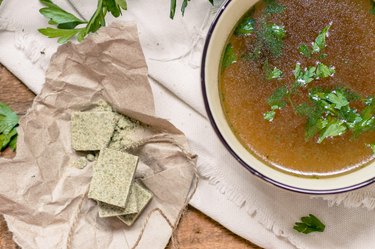
If you're making chicken soup or a chicken gravy, you're going to need chicken broth. Making chicken broth from bouillon cubes is a lot faster than making it from scratch, and it means you don't have to clutter up your pantry shelves with cans of chicken stock.
Vegetable, beef and chicken bouillon cubes are easily available at grocery stores and are not too expensive. You can also buy chicken bouillon powder instead of cubes if you prefer. There is no real difference between chicken bouillon powder and chicken bouillon cubes; the ingredients and flavor are usually the same, just the form is slightly different. Many manufacturers offer both forms.
Video of the Day
Video of the Day
Chicken Broth From Bouillon Cubes
Making chicken broth from bouillon cubes is easy and won't take long. You will need only a measuring cup and a pot in addition to the bouillon cubes. Just follow these steps:
- Boil water: Measure out the amount of water your recipe requires. For example, if your recipe calls for 3 cups of broth, use 3 cups of water. Purdue University recommends boiling the water before you add the bouillon cube. Pour the water into a pot and bring it to a boil on the stove.
- Add the chicken bouillon cubes: The instructions on the package will tell you the proportion of bouillon cubes to water and you'll have to use that to calculate how many cubes to add. For example, if the instructions say you need to use one chicken bouillon cube per cup of water, you will need to add three cubes to 3 cups of water. Packets of chicken bouillon powder will also specify the proportions to use.
- Stir the mixture: Stir the mixture well until the bouillon cubes have completely dissolved and you have a uniform broth. Use the broth in the recipe as required.
Watch Out for the Sodium
Broths and stocks are notorious for having a high sodium content. Michigan State University (MSU) notes that many varieties of broth can have more than 700 milligrams of sodium per serving. If you consume more than one serving, that's even more sodium.
So, are low-sodium broths healthy? Not exactly. According to the Mayo Clinic, even low-sodium broths can have a lot of sodium. Make sure you check the label to see how much sodium each serving has. Also keep an eye out for monosodium glutamate, or MSG, since some manufacturers may add it to the bouillon to enhance the flavor.
If you're using bouillon cubes, avoid adding more salt to the food while you cook. MSU also suggests using fewer bouillon cubes than the prescribed amount, to help reduce the amount of sodium. Alternatively, you could make your own broth. It's more time-consuming; however, at least that way you can keep the sodium level in check.
The American Heart Association (AHA) prescribes an ideal limit of 1,500 milligrams of sodium per day for most adults, with an upper limit of 2,300 milligrams of sodium per day. According to the AHA, Americans consume more than 3,400 milligrams of sodium per day on average.
Regulating your sodium consumption could significantly boost your heart health and improve your blood pressure levels. An April 2013 study published in the BMJ found that even a modest reduction in your salt intake for a month or more could result in a significant improvement in blood pressure.
Your kidneys will also thank you for eating less sodium; the Journal of Clinical Hypertension (Greenwich) published a study in December 2018 linking high-sodium diets to kidney disease.
- Michigan State University: “Make Your Own Chicken Broth”
- Mayo Clinic: “DASH Diet: Tips for Shopping and Cooking”
- Michigan State University: “Homemade Soup From Scratch”
- American Heart Association: “How Much Sodium Should I Eat Per Day?”
- BMJ: “Effect of Longer Term Modest Salt Reduction on Blood Pressure: Cochrane Systematic Review and Meta-analysis of Randomised Trials”
- Journal of Clinical Hypertension: “High Sodium Intake Increases Blood Pressure and Risk of Kidney Disease”
- Purdue University: “Ingredient Substitutions”